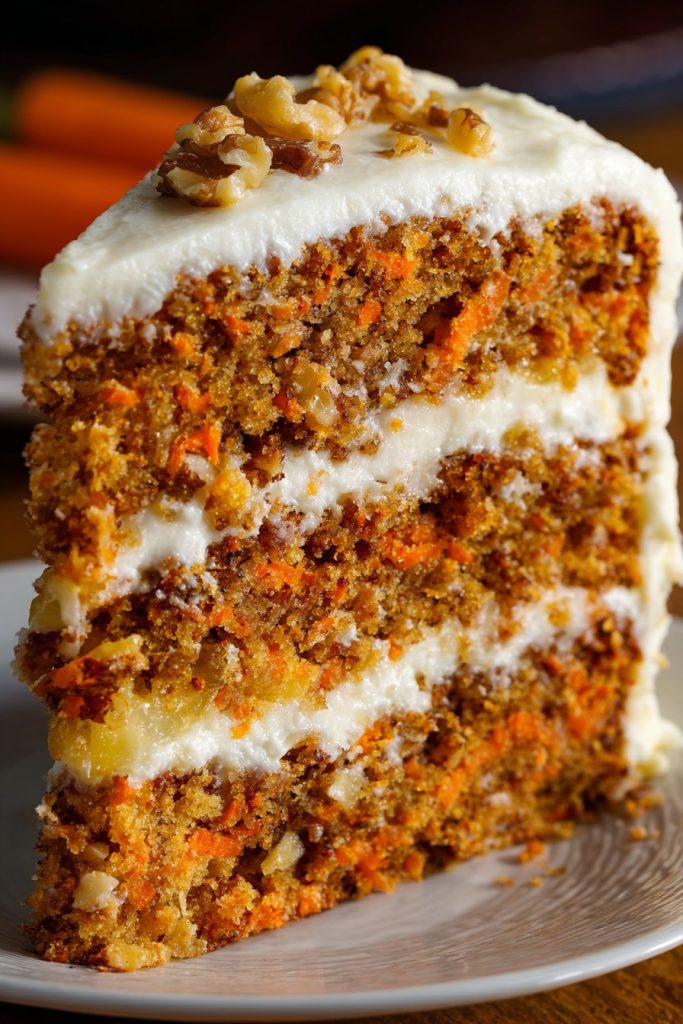This sophisticated carrot cake variation elevates the classic dessert with tropical pineapple notes and precise technical execution. The inclusion of crushed pineapple not only enhances moisture retention but also introduces subtle acidity that balances the sweetness profile, while maintaining the structural integrity essential for professional-level baking.
Why This Recipe Works
- The incorporation of crushed pineapple provides natural enzymatic tenderization while contributing both moisture and subtle acidity that cuts through the richness of the cream cheese frosting
- Utilizing both baking powder and baking soda creates a dual-leavening system that ensures optimal rise during the initial oven spring and continued expansion throughout the baking process
- Toasting the walnuts at 350°F for 8-10 minutes before incorporation develops deeper nutty flavors through Maillard reactions while preventing sogginess in the final cake texture
- The cream cheese frosting employs a reverse-creaming method where butter is beaten until pale before adding cream cheese, creating superior emulsion stability and preventing the common issue of weeping or separation
- Resting the grated carrots for 15 minutes after salting draws out excess moisture through osmosis, concentrating their natural sweetness while preventing the batter from becoming overly wet during mixing
Ingredients
- 2 cups all-purpose flour, sifted
- 2 teaspoons baking powder
- 1 teaspoon baking soda
- 1½ teaspoons ground cinnamon
- ½ teaspoon ground nutmeg
- ¼ teaspoon ground ginger
- ½ teaspoon fine sea salt
- 3 cups finely grated carrots (about 6 medium carrots), excess moisture pressed out
- 1 cup crushed pineapple, thoroughly drained and pressed
- 1 cup chopped walnuts, toasted
- 4 large eggs at room temperature
- 1½ cups granulated sugar
- 1 cup light brown sugar, packed
- 1 cup vegetable oil
- 2 teaspoons pure vanilla extract
- 16 ounces full-fat cream cheese, softened to 65°F
- ½ cup unsalted butter, softened to 65°F
- 4 cups powdered sugar, sifted
- 1 teaspoon fresh lemon juice
Equipment Needed
- 9-inch round cake pans (2)
- Parchment paper rounds
- Stand mixer with paddle attachment
- Digital kitchen scale
- Instant-read thermometer
- Cooling racks
- Microplane grater
- Fine-mesh sieve
- Offset spatula
- Rotating cake turntable
Instructions

Prepare Dry Ingredients and Toast Nuts
Begin by sifting 2 cups of all-purpose flour through a fine-mesh sieve into a large mixing bowl to aerate and remove any lumps. To this, add 2 teaspoons baking powder, 1 teaspoon baking soda, 1½ teaspoons ground cinnamon, ½ teaspoon ground nutmeg, ¼ teaspoon ground ginger, and ½ teaspoon fine sea salt. Use a whisk to combine these dry ingredients thoroughly, ensuring even distribution of leavening agents and spices throughout the flour base. Meanwhile, spread 1 cup of chopped walnuts in a single layer on a baking sheet and toast in a preheated 350°F oven for 8-10 minutes, until fragrant and lightly golden. Watch carefully during the final minutes to prevent burning, as the high oil content in walnuts causes them to transition from perfectly toasted to burnt quickly. Remove from oven and let cool completely before incorporating into the batter. This toasting step develops complex Maillard reaction flavors that will complement the sweet carrots and pineapple. Pro Tip: For maximum flavor extraction, toast your spices in a dry skillet over medium heat for 30-60 seconds before grinding or measuring, which releases their essential oils and intensifies their aromatic qualities.
Prepare Wet Ingredients and Combine Batter
Bake and Test for Doneness
Divide the batter evenly between two prepared 9-inch round cake pans that have been greased, lined with parchment rounds, and lightly floured. Use a digital scale for precision if available, aiming for approximately 650-700 grams of batter per pan. Smooth the tops with an offset spatula and tap the pans firmly on the counter to release any large air bubbles. Bake in the center of a preheated 350°F oven for 30-35 minutes, rotating the pans front to back halfway through the baking time. The cakes are done when the centers spring back when lightly pressed, the edges pull away slightly from the pan sides, and an instant-read thermometer inserted into the center registers between 200-205°F. Avoid the toothpick test, as the moist pineapple and carrot content can give false readings. Pro Tip: For perfectly level cakes that require minimal trimming, wrap damp cake strips around the outside of your pans before baking; this slows edge cooking and promotes even rising.
Prepare Cream Cheese Frosting
While the cakes cool completely on wire racks, prepare the cream cheese frosting using the reverse-creaming method for superior stability. In the clean bowl of a stand mixer fitted with the paddle attachment, beat ½ cup of softened unsalted butter on medium speed for 3-4 minutes until pale and fluffy. Gradually add 4 cups of sifted powdered sugar with the mixer on low speed until fully incorporated. Increase speed to medium-high and beat for 2 minutes until light and airy. Add 16 ounces of softened full-fat cream cheese in three additions, beating just until combined after each. Finally, mix in 1 teaspoon of fresh lemon juice. Do not overbeat after adding the cream cheese, as this can cause the frosting to become too soft and difficult to work with. The finished frosting should be smooth, spreadable, and hold medium peaks. Pro Tip: For the creamiest frosting texture, ensure both butter and cream cheese are at exactly 65°F before beginning; this temperature provides the ideal plasticity for proper emulsification.
Assemble and Finish the Cake
Place one completely cooled cake layer on a cardboard round or serving plate atop a rotating cake turntable. Using an offset spatula, spread approximately 1 cup of frosting evenly over the top, extending just to the edges. Carefully place the second cake layer on top, ensuring it’s centered and level. Apply a thin crumb coat of frosting over the entire cake, using a bench scraper to create smooth sides. Chill the cake for 20-30 minutes until the crumb coat is firm to the touch. Apply the remaining frosting in a thicker final coat, using the turntable and bench scraper to achieve sharp, clean edges. For decorative piping, reserve about ½ cup of frosting. The finished cake should be refrigerated for at least 2 hours before serving to allow the flavors to meld and the structure to set properly for clean slicing.
Tips and Tricks
For professional-level carrot cake execution, several advanced techniques can elevate your results beyond the basic recipe. When preparing the carrots, consider using a microplane grater for the finest texture, which distributes more evenly throughout the batter and creates a more uniform crumb structure. For pineapple preparation, avoid canned pineapple in heavy syrup; instead opt for pineapple packed in its own juice or fresh pineapple that you’ve crushed and drained thoroughly. The draining process is critical—place the crushed pineapple in a fine-mesh strainer and press firmly with the back of a spoon or use cheesecloth to squeeze out as much liquid as possible. Excess moisture is the enemy of proper cake structure and can lead to gummy spots or sinking in the center.
Temperature management throughout the baking process cannot be overstated. All ingredients should be at room temperature (68-72°F) before beginning, as this ensures proper emulsion and even mixing. When testing for doneness, rely on both visual cues and internal temperature. The cake should show slight pulling away from the pan edges, spring back when gently pressed in the center, and register 200-205°F on an instant-read thermometer. Cooling methodology significantly impacts final texture—cool the cakes in their pans on wire racks for 15 minutes before turning out, then cool completely before frosting. This gradual cooling prevents condensation and structural collapse.
For frosting application mastery, the crumb coat is non-negotiable. This thin initial layer traps loose crumbs and provides a smooth base for the final coat. When applying the final frosting layer, work efficiently but not hastily, as overworking can incorporate air bubbles and cause the frosting to become too warm. If your kitchen is particularly warm, consider chilling the frosting for 10-15 minutes before the final application. For decorative elements, toasted coconut flakes pressed into the sides provide both visual interest and textural contrast, while candied carrot curls make an elegant garnish that hints at the cake’s primary flavor component.
Recipe Variations
- For a tropical coconut variation, replace ½ cup of the vegetable oil with coconut oil and add 1 cup of toasted sweetened coconut flakes to the batter. Enhance the coconut flavor in the frosting by replacing 2 tablespoons of the butter with coconut oil and folding in ½ cup of finely shredded coconut. This variation pairs exceptionally well with the pineapple and creates a more pronounced island-inspired profile that maintains the cake’s structural integrity while introducing new flavor dimensions.
- Create a spiced rum version by reducing the vanilla extract to 1 teaspoon and adding 2 tablespoons of dark spiced rum to the wet ingredients. Soak ½ cup of raisins in ¼ cup of warm rum for 30 minutes before draining and incorporating them along with the walnuts. The alcohol will mostly bake out while leaving behind complex flavor notes that complement the warm spices. For adults-only serving, brush the cooled cake layers with an additional tablespoon of rum before frosting.
- For a nut-free adaptation, omit the walnuts and replace them with ½ cup of toasted sunflower seeds and ½ cup of old-fashioned oats that have been pulsed briefly in a food processor. The sunflower seeds provide similar textural contrast while the oats absorb excess moisture and contribute to a heartier crumb structure. This variation maintains the desired texture complexity while accommodating dietary restrictions without compromising on the cake’s fundamental characteristics.
- Transform the recipe into carrot cake cupcakes by dividing the batter among 24 standard muffin cups lined with paper liners. Reduce baking time to 18-22 minutes at 350°F until the centers spring back when lightly pressed. For professional presentation, use a piping bag fitted with a large star tip to apply the cream cheese frosting in decorative swirls. These individual portions are ideal for events where precise portion control and easy serving are priorities.
Frequently Asked Questions
Can I use fresh pineapple instead of canned crushed pineapple?
Absolutely, fresh pineapple can be used with proper preparation to achieve the correct moisture content. Select a ripe pineapple and remove the skin and core before crushing the flesh using a food processor or manual chopping. The critical step is thorough draining—place the crushed fresh pineapple in a fine-mesh strainer set over a bowl and let it drain for at least 30 minutes, occasionally pressing with the back of a spoon to extract excess liquid. Fresh pineapple contains more active bromelain enzyme, which can affect protein structure, but the baking process will deactivate this enzyme. The advantage of fresh pineapple is brighter, more vibrant flavor, though it requires additional preparation time compared to the convenience of canned products.
Why did my cream cheese frosting become runny or separate?
Runny cream cheese frosting typically results from three common issues: ingredient temperature imbalance, overmixing, or using low-fat cream cheese. For optimal emulsion, both butter and cream cheese must be at precisely 65°F—too warm and the fat structure breaks down, too cold and proper incorporation becomes difficult. Overmixing after adding the cream cheese introduces excess air and heat, causing separation. Always use full-fat cream cheese, as reduced-fat varieties contain additional stabilizers and higher water content that disrupt the fat-to-sugar ratio necessary for proper frosting consistency. If your frosting becomes too soft, chilling for 20-30 minutes often restores workable texture without needing additional thickeners.
How should I store this cake and how long will it keep?
Due to the high moisture content from carrots and pineapple and the dairy-based frosting, this cake requires refrigeration. Store in an airtight container or well-wrapped in plastic wrap in the refrigerator for up to 5 days. The flavors actually improve and meld over the first 24-48 hours. For serving, remove the cake from refrigeration 1-2 hours before serving to allow it to come to room temperature, which restores the optimal texture and flavor expression. For longer storage, unfrosted cake layers can be tightly wrapped and frozen for up to 3 months, while frosted cakes don’t freeze well due to texture changes in the cream cheese frosting component.
Can I make this recipe as a sheet cake instead of layer cake?
Yes, this recipe adapts beautifully to a 9×13-inch sheet pan with adjusted baking time and technique. Grease and line the pan with parchment paper, extending the paper up two sides for easy removal. Spread the batter evenly into the prepared pan and bake at 350°F for 35-40 minutes, until the center springs back when lightly pressed and registers 200-205°F on an instant-read thermometer. The larger surface area means the cake will bake more quickly and evenly. For serving, you can frost the cake directly in the pan or carefully remove it using the parchment sling for presentation on a serving platter. Sheet cake version is ideal for larger gatherings where layer cake slicing might be impractical.
Summary
This professionally developed carrot cake with pineapple achieves perfect moisture balance through precise ingredient preparation and technical execution. The dual-leavening system, proper draining techniques, and reverse-creaming frosting method create a dessert worthy of any culinary occasion while maintaining structural integrity and complex flavor development.



